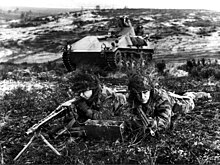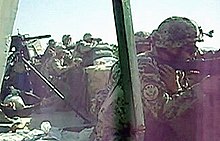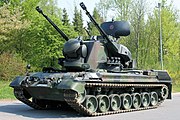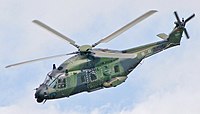German Army: Difference between revisions
ClueBot NG (talk | contribs) m Reverting possible vandalism by 50.200.57.174 to version by Denniss. False positive? Report it. Thanks, ClueBot NG. (1772786) (Bot) |
No edit summary |
||
| Line 1: | Line 1: | ||
{{about| |
{{about|hi modern army of Germany and post-World War II army of West Germany|the World War II army of Germany|German Army (1935–1945)|the World War I army of Germany|German Army (German Empire)}} |
||
{{Infobox military unit |
{{Infobox military unit |
||
|unit_name='''German Army''' <br /> '''''Deutsches Heer''''' |
|unit_name='''German Army''' <br /> '''''Deutsches Heer''''' |
||
Revision as of 19:36, 31 March 2014
| German Army Deutsches Heer | |
|---|---|
 Logo of the German Army | |
| Active | 1955–present |
| Country | Federal Republic of Germany |
| Role | Land force |
| Size | 62,279[1] |
| Motto(s) | To protect, help, moderate, and fight Schützen, helfen, vermitteln, kämpfen |
| Colors | Green, "Sand" and White |
| Anniversaries | November 12, 1955 |
| Engagements | United Nations Operations in Somalia Aftermath of the Balkan Wars 1995-1999 Kosovo War Battle of Tetovo Operation Essential Harvest War in Afghanistan North Kosovo crisis |
| Decorations | Badge of Honour of the Bundeswehr Military Proficiency Badge Badge of Marksmanship Service Medal Flood Service Medal |
| Commanders | |
| Current commander | Lieutenant General Werner Freers |
| Notable commanders | General Ulrich de Maizière General Ernst Ferber, COMAFCENT 1973–1975 Lieutenant General Jörg Schönbohm, later Undersecretary of Defense |
The German Army (German: Deutsches Heer) is the land component of the armed forces of the Federal Republic of Germany. The German Army was founded in 1955 as part of the newly formed West German Bundeswehr along with the Marine (Navy) and the Luftwaffe (Air Force). As of June 2013, the German Army has a strength of 62,279 soldiers.
History
Overview
A German Army, equipped, organized and trained following a single doctrine, and permanently unified under one command dates from 1871, and the unification of Germany under the leadership of Prussia. From 1871 to 1919 the title Deutsches Heer (German Army) was the official name of the German land forces. Following the German defeat in World War I and the end of the German Empire the name army dissolved. From 1921 to 1935 the name of the German land forces was Reichsheer (Army of the Realm) and from 1935 to 1945 the name Heer was used. The Heer was one of two ground forces of the Third Reich during World War II, but unlike the Heer the Waffen SS was not a branch of the Wehrmacht. The Heer ceased to exist in 1945.
After World War II Germany was split into two sovereign states and both formed their own militaries: on 12 November 1955 the first recruits began their service in the West German Heer, while on 1 March 1956 the East German Landstreitkräfte der NVA (Land Forces of the National People's Army) were founded. During the Cold War the West German Army was fully integrated into NATOs command structure, while the Landstreitkräfte were part of the Warsaw Pact. Following the German reunification in 1990 the Landstreitkräfte were partially integrated into the German Army. Since then the German Army has been employed in peacekeeping operations worldwide and since 2002 also in combat operations in Afghanistan as part of NATOs International Security Assistance Force.
Traditions can be traced between the Imperial Deutsches Heer, the Weimar Reichsheer and the Third Reich Heer. However after World War II the architects of the new Heer chose not to continue any traditions of any of the previous armies. The only permitted historical antecedents for today's Heer are the 1807 to 1814 Prussian military reformers and the servicemen who participated actively in the resistance against the Nazi regime, specifically the officers involved in the 20 July plot.
Founding of the Army

Following World War II the Allies dissolved the Wehrmacht with all its branches on 20 August 1946. However already one year after the founding of the Federal Republic of Germany in May 1949 and because of its increasing links with the West under German chancellor Konrad Adenauer, the Consultative Assembly of Europe began to consider the formation of a European Defence Community with German participation on 11 August 1950. Former high-ranking German Wehrmacht officers outlined in the Himmeroder memorandum a plan for a "German contingent in an international force for the defense of Western Europe." For the German land forces the memorandum envisioned the formation of a 250,000 strong army. The officers saw the need for the formation of twelve Panzer divisions and six corps staffs with accompanying Corps troops, as only armored divisions could muster a fighting force to throw back the numerically far superior forces of the Warsaw Pact.[2]
On 26 October 1950 Theodor Blank was appointed "officer of the Federal Chancellor for the Strengthening of Allied Troops questions". This Defence Ministry forerunner was known somewhat euphemistically as the Blank Office (Amt Blank), but explicitly used to prepare for the rearmament of West Germany (Wiederbewaffnung).[3] By March 1954 the Blank Office had finished plans for a new German army. Plans foresaw the formation of six infantry, four armoured, and two mechanised infantry divisions, as the German contribution to the defense of Western Europe in the framework of a European Defence Community.[2] On 8 February 1952 the Bundestag approved a German contribution to the defense of Western Europe and on 26 February 1954 the Basic Law of the Republic was amended with the insertion of an article regarding the defence of the sovereignty of the federal government.[4] Following a decision at the London Nine Power Conference of 28 September to 3 October 1954, Germany's entry into NATO effective from 9 May 1955 was accepted as a replacement for the failed European Defence Community plan. Afterwards the Blank Office was converted to the Defence Ministry and Theodor Blank became the first Defence Minister. The nucleus of army was the so-called V Branch of the Department of Defence. Subdivisions included were VA Leadership and Training, VB Organisation and VC Logistics.
The army saw itself explicitly not as a successor to the defeated Wehrmacht, but as in the traditions of the Prussian military reformers of 1807 to 1814 and the members of the military resistance during National Socialism; such as the officers which undertook the failed 20 July plot to assassinate Hitler in 1944. Nevertheless, for lack of alternatives the officer corps was made up largely of former Wehrmacht officers. The first Chief of the Army was the former Wehrmacht General der Panzertruppe Hans Rottiger, who had been involved in the drafting of the Himmeroder memorandum.
The official date of the founding of the army is 12 November 1955 when the first soldiers began their service in Andernach.[5] In 1956 the first troops set up seven training companies in Andernach and began the formation of schools and training centers. On 1 April 1957, the first conscripts arrived for service in the army. The first military organisations created were instructional battalions, officer schools, and the Army Academy, the forerunner to the Führungsakademie der Bundeswehr in Hamburg.[4] In total of twelve armoured and infantry divisions were to be established by 1959, as planned in Army Structure I. To achieve this goal existing units were split approximately every six months. However the creation of all twelve divisions did not take place until 1965. At the end of 1958 the strength of the army was about 100,000 men. The army was equipped at first with American material, such as the M-47 Patton main battle tank. Three corps commands were formed beginning in 1957: the I Corps, II Corps, and the III Corps.
Also in 1957 the "Office for Territorial Defence" was established as the highest Territorial Army authority. The Office for Territorial Defence was under the direct command of the Federal Ministry of Defence and commanded the Territorialheer a reserve formation. While the Heer along with the Marine and Luftwaffe were firmly integrated into NATO command structures the Territorialheer remained under national command. The main function of the Territorialheer was to maintain the operational freedom of NATO forces through providing rear area defence against saboteurs, enemy special forces, and the like.

The development of Soviet tactical nuclear weapons required the development of a new Army structure even before Army Structure I was fully achieved. To minimize the effects of attacks with tactical nuclear weapons on massed forces, the 28,000 strong divisions of the Heer were broken up into smaller and more mobile brigades. These smaller units were also to be capable of self-sustainment on an atomic battlefield for several days, and to be capable of to move quickly from defense and to attack. The new armoured and mechanized brigades were capable of combined arms combat. Each division was composed of three brigades. The armoured brigades consisted of an armoured infantry battalion, two armoured battalions, an armoured artillery battalion and a supply battalion. The mechanized brigades consisted of a motorized infantry battalion, two mechanized infantry battalions, an armored battalion, a field artillery battalion and a supply battalion. The motorized brigades consisted of three motorized infantry battalions, an anti-tank battalion, a field artillery battalion and a supply battalion. The alpine brigades consisted of three alpine battalions, a mountain artillery battalion and a supply battalion. By 1959 the Heer consisted of 11 divisions of 27 brigades, four Panzer (armoured), four Panzergrenadier (mechanized), two Jäger (motorized), and one Gebirgsjäger (alpine).
Post Cold War

After 1990, the Heer absorbed the army of East Germany, a part of the Nationale Volksarmee. The former East German forces were initially commanded by the Bunderwehr Command East under command of Lieutenant General Jörg Schönbohm and disbanded on 30 June 1991.[6] In the aftermath of the merger, the German Army consisted of four Corps (including IV Corps at Potsdam in the former DDR) with a manpower of 360,000 men. It was continuously downsized from this point. In 1994 III Corps was reorganised as the German Army Forces Command. In 1996, the 25th Airborne Brigade was converted into a new command leading the Army's special forces, known as the Kommando Spezialkräfte.
The 2001 onwards restructuring of the German Army saw it move to a seven division structure – 5 mechanized (each with two mechanized brigades), 1 special forces, and one airmobile.
In 2003, three Corps still existed, each including various combat formations and a maintenance brigade. I. German/Dutch Corps, a joint German-Netherlands organization, used to control in peacetime the 1st Panzer and 7th Panzer Divisions as well as Dutch formations. The 1st Panzer would have reported to the corps in wartime while the 7th would be posted to the Allied Rapid Reaction Corps. II Corps was German in peacetime but would have exchanged a division with the V U.S. Corps in time of war (the 5th Panzer). 5th Panzer Division disbanded as of 30 June 2001. In peacetime it also commanded the 10th Panzer Division, which was allocated to Eurocorps and which parents the German half of the Franco-German Brigade. The 1st Mountain Division at Munich was also under this headquarters.
The IV Corps was headquartered at Potsdam in eastern Germany and controlled two Panzer-Grenadier Divisions, the 13th and 14th. The 14th Panzer-Grenadier Division also took control of units in Western Germany re-subordinated from the 6th Panzer-Grenadier Division when it lost its command function. It would have made up the German contribution to the Multinational Corps Northeast in time of war. IV Corps also used to have under its command the Military District Command I, the 1st Air Mechanised Brigade, and the Berlin Command (de:Standortkommando Berlin).
German Army today
All corps have now been disbanded or transferred to a multinational level such as Multinational Corps North East. IV Corps was reorganized and on 31 March 2002 became an overseas deployment command, the Einsatzführungskommando der Bundeswehr, like the British Permanent Joint Headquarters. A planned army reorganisation/reduction in 2012 will see the disbandment of the 13th Mechanized Infantry Division headquarters, a merge of the Airmobile Operations Division and Special Operations Division headquarters, the disbandment of the 1st Airmobile Brigade, and reshuffling of units between divisions.[citation needed] No heavy brigades will be disbanded, but the two remaining heavy divisions will command three rather than two brigades.
A total of 62,279 soldiers are currently (February 2013) on active service in the German Army.[1]
Modern equipment
-
Leopard 2A6 main battle tank
-
PzH2000 self-propelled artillery
-
Gepard 1a2 air-defence artillery guns
-
NH-90 transport helicopter
Structure and organisation
large pin - division, small pin - brigade

The German Army is commanded by the Inspector of the Army (Inspekteur des Heeres) based at the Army Command in Strausberg near Berlin. The training centers are supervised by the Army Training Command in Leipzig.



The combat units of the army include two armored divisions with three brigades each, one rapid forces division and the Franco-German Brigade, which is under direct supervision of the Army Command. Depending on their size and role, brigades can be commanded either by a Brigadier General alike or a Colonel. Unlike other European armies such of neighbouring Netherlands and France, regiments are not a common form of organization and are thus rare in the German army. Battalions are directly subordinate to brigades or to divisions as divisional troops.
 Division Intervention Forces/ 1st Armoured Division (Hannover)
Division Intervention Forces/ 1st Armoured Division (Hannover)
- Divisional troops
- Panzerlehrbrigade 9 (9th Armoured Demonstration Brigade)
- Panzerbrigade 21 (21st Armoured Brigade "Lipperland")
- 41st Mechanized Infantry Brigade "Vorpommern"
 10th Armoured Division (Veitshöchheim)
10th Armoured Division (Veitshöchheim)
- Divisional troops
- 12th Armoured Brigade "Oberpfalz"
- 23rd Mountain Infantry Brigade "Bayern"
- 37th Mechanized Infantry Brigade "Freistaat Sachsen"
 Special Operations Division (Stadtallendorf)
Special Operations Division (Stadtallendorf)
- Divisional troops
- Special Forces Command (KSK)
- 26th Airborne Brigade "Saarland"
 Eurocorps (Straßburg)
Eurocorps (Straßburg)
- Command Support Brigade
- German elements in two permanent battalions and one staff company
 1 (German/Netherlands) Corps (Münster)
1 (German/Netherlands) Corps (Münster)
- German elements in two permanent battalions and one staff company
 Multinational Corps North East (Stettin)
Multinational Corps North East (Stettin)
- 610th Signal Battalion
- German elements
 Army Central Dump Herongen
Army Central Dump Herongen
 Army Central Dump Pirmasens
Army Central Dump Pirmasens
 Central Mobilisation Base in Brück
Central Mobilisation Base in Brück
Truppengattungen
The German Army has eleven different branches of troops, designated as Truppengattungen. Each Truppengattung is responsible for training and readiness of its units and disposes of its own schools and centres of excellence for doing so. Optically this distinction can be made by the branch colour, called Waffenfarbe which is displayed by a cord attached to the rank insignia, and the colour of their beret with a specific badge attached to it.
Beret Colour (Army only and Security Units of Navy and Air Force)
- Black: Armoured Corps, Reconnaissance Corps
- Green: Mechanized Infantry and Rifles Corps
- Dark Red: Aviation Corps, Airborne Corps, Special Forces, formations assigned to airborne division
- Light Red: Combat Support Corps and Military Police
- Dark Blue: Medical Corps
- Navy Blue: Multinational Units, Officer Cadet Battalions, Navy and Air Force Security Units
- Bright Blue: Troops with United Nations Missions
Grey mountain cap (Bergmütze): Mountain Troops Gebirgsjäger
Waffenfarbe (Army and army support branch only)
-
NBC
-
Artillery
-
Military Police
-
Signals
-
Reconnaissance
-
Army Aviation
-
Army Air Defence
-
Technical Troops
-
Infantry
-
Military band
-
Armoured Troops (i.e. Tanks)
-
Pioneers (i.e. Engineering)
-
Medical Troops
- Bright Red:General ranks (only "Kragenspiegel", not "Litze"),
- Crimson: General Staff
Rank structure
The rank structure of the German army is adjusted to the rank structure of the NATO. Unlike its predecessors, the modern German Army does not use the rank of Colonel General.
The highest rank for an army officer is Lieutenant General, as the rank of Full General is reserved for the Armed Forces chief of staff or officers serving as NATO officers.
Officer cadets do not pass through all enlisted ranks, but are directly promoted to Lieutenant after 36 months of service.
Equivalent US Army ranks are shown below according to "STANAG 2116 NSA MC LO (EDITION 6) – NATO CODES FOR GRADES OF MILITARY PERSONNEL":
| Officers of the German Army | ||||||||||
|---|---|---|---|---|---|---|---|---|---|---|
| General (General) Gen |
Lieutenant General (Generalleutnant) GenLt/GL |
Major General (Generalmajor) GenMaj/GM |
Brigadier General (Brigadegeneral) BrigGen/BG |
Colonel (Oberst) Oberst/O |
Lieutenant Colonel (Oberstleutnant) Oberstlt/OTL | |||||
| OF-9 | OF-8 | OF-7 | OF-6 | OF-5 | OF-4 | |||||

|

|

|

|

|

| |||||
| Officers of the German Army | ||||||||||
|---|---|---|---|---|---|---|---|---|---|---|
| Major (Major) Maj/M |
Staff Captain (Stabshauptmann) StHptm/SH |
Captain (Hauptmann) Hptm/H |
1st Lieutenant (Oberleutnant) OLt /OL |
2nd Lieutenant (Leutnant) Lt/L | ||||||
| OF-3 | OF-2 | OF-2 | OF-1 | OF-1 | ||||||

|

|

|

|

| ||||||
| Non-Commissioned Officers of the German Army | ||||||||||
|---|---|---|---|---|---|---|---|---|---|---|
| Sergeant Major (Oberstabsfeldwebel) OStFw/OSF |
Master Sergeant (Stabsfeldwebel) StFw/SF |
Sergeant 1st Class (officer cadet) (Oberfähnrich) OFähnr/OFR |
Sergeant 1st Class (Hauptfeldwebel) HptFw/HF |
Staff Sergeant (Oberfeldwebel) OFw/OF | ||||||
| OR-9 | OR-8 | OR-8 | OR-7 | OR-6 | ||||||

|

|

|

|

| ||||||
| Non-Commissioned Officers of the German Army | ||||||||||
|---|---|---|---|---|---|---|---|---|---|---|
| Staff Sergeant (officer cadet) (Fähnrich) Fähnr/FR |
Staff Sergeant (Feldwebel) Fw/F |
Sergeant (Stabsunteroffizier) StUffz/SU |
Corporal (officer cadet) (Fahnenjunker) Fhj/FJ |
Corporal (Unteroffizier) Uffz/U | ||||||
| OR-6 | OR-6 | OR-5 | OR-5 | OR-5 | ||||||

|

|

|

|

| ||||||
| Enlisted Ranks of the German Army | ||||||||||
|---|---|---|---|---|---|---|---|---|---|---|
| Corporal Specialist (Oberstabsgefreiter) OStGefr/OSG |
Specialist (Stabsgefreiter) StGefr/SG |
Lance Corporal (Hauptgefreiter) HptGefr/HG |
Private 1st Class (NCO cadet) (Obergefreiter UA) OGefr/OG |
Private 1st Class (Obergefreiter) OGefr/OG | ||||||
| OR-4 | OR-4 | OR-3 | OR-3 | OR-3 | ||||||

|

|

|

|

| ||||||
| Enlisted Ranks of the German Army | ||||||||||
|---|---|---|---|---|---|---|---|---|---|---|
| Private 1st Class (officer cadet) (Gefreiter OA) Gefr/G |
Private 1st Class (Sergeant cadet) (Gefreiter FA) Gefr/G |
Private 1st Class (NCO cadet) (Gefreiter UA) Gefr/G |
Private 1st Class (Gefreiter) Gefr/G |
Private (Soldat) S | ||||||
| OR-2 | OR-2 | OR-2 | OR-2 | OR-1 | ||||||

|

|

|

|

| ||||||
See also
- Kaiserliche Armee
- Bundeswehr
- History of Germany during World War II
- Infantryman of the Future
- Imperial Army (German Empire) (to 1806)
- Prussian Army
- Reichswehr
- Tank Battalions of the German Army 1956 - 2008
References
- ^ a b Die Stärke der Streitkräfte
- ^ a b For a discussion on German defence planning in the context of the EDC, see Abenheim, Reforging the Iron Cross, Chap. 5 (Zilian, p.41)
- ^ See Frederick Zilian Jr., 'From Confrontation to Cooperation: The Takeover of the National People's (East German) Army by the Bundeswehr,' Praeger, Westport, Conn., 1999, ISBN 0-275-96546-5, p.40-41, for a discussion of this period
- ^ a b Zilian, p.41
- ^ Adenauers Geheimnis
- ^ See Jorg Schonbohm, 'Two Armies and One Fatherland', Berghahn Books, Providence & Oxford, 1996
Further reading
- Hubatscheck, Gerhard (2006), 50 Jahre Heer. Der Soldat und seine Ausrüstung, Sulzvach: Report-Verlag, ISBN 978-3-932385-21-6
- Wheeler-Bennet, Sir John (2005), The Nemesis of Power: German Army in Politics, 1918-1945 (2nd ed.), New York: Palgrave Macmillan Publishing Company, ISBN 978-1-4039-1812-3
- Catherine M. Kelleher, ‘Fundamentals of German Security: The Creation of the Bundeswehr: Continuity and Change,’ in Stephen F. Szabo (ed.), The Bundeswehr and Western Security, St. Martin’s Press, New York, 1990.
External links
Historical links
- German Army pre 1914
- German Army 1914-1918
- German Army Organization 1914
- German Infantry Photographs from World War II - Colour photographs of German infantry during World War II
- Gebirgsjaeger - German Mountain Troops
- Axis History - Axis History site including German troops.





